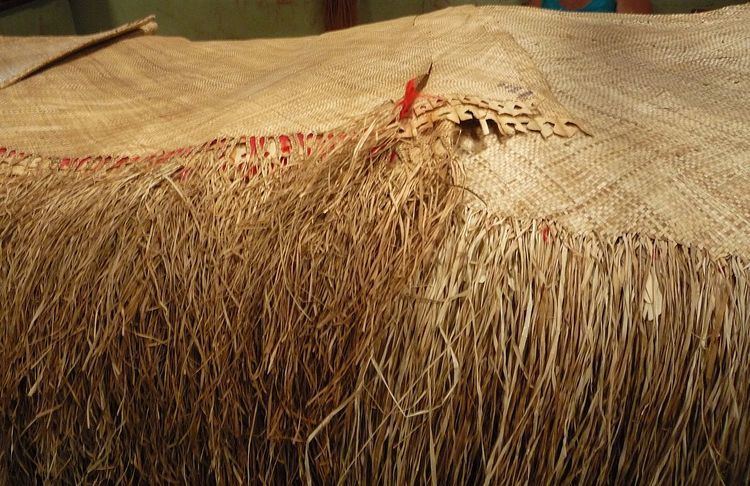 | ||
A ʻie tōga is a special finely woven mat that is the most important item of cultural value in Sāmoa. They are commonly referred to in English as "fine mats" although they are never used as 'mats' as they only have a purely cultural value. ʻIe tōga are valued by the quality of the weave and the softness and shine of the material. They are made by women and form an important part of their role, identity and skill in their community.
Contents
ʻIe tōga have an unwoven fringe and a strip of red feathers. They are important in gift exchanges during cultural ceremonies and events including matai chief title bestowals, weddings and funerals. In this way, ʻie tōga are passed from family to family, sometimes for many years and are greatly valued. Historically, some ʻie tōga were so valuable they were given their own names. The process of making a fine ʻie tōga can take months of work and have been known to take years. The completion of ʻie tōga can involve a public celebration and presentation with the women parading and displaying their fine mats for all to see.
Cultural value
ʻIe tōga are never used as an actual floor mat in the western sense, functioning only as an item of cultural value. They are considered the most precious item in ceremony and gift exchanges, important in faʻa-Sāmoa. They represent most of the traditional wealth of Sāmoan families. They are exchanged and presented at weddings and funerals, and at special occasions such as the blessing of a newly built fale (house) or the opening of a new church. ʻIe tōga are sometimes worn at special occasions, around the waist, similar to a lavalava. At funerals ʻie tōga are given to the family of the deceased and gifts of mats and food are given in return. These exchanges display a mutual respect that enforces family (ʻaiga) ties.
Process
The best quality of ʻie tōga are made from a variety of long leaved pandanus known as lauʻie. More common types of 'ie toga with a coarser weave are made from laufala, a variety of pandanus which has a darker green colour than the lauʻie plant. The pandanus are grown in village plantations. The long leaves are selected and cut from the plant and taken back to the village. The leaves are prepared by soaking in boiling water followed by drying and bleaching in the sun. Once dry, the leaves are rolled and tied into bundles in preparation for weaving. The long dried leaves are then slit into thin strips for weaving. In the 19th century, young women would start their own mats or complete ones started by older sisters. Today, it is more common for mats to be woven by a group of women working in a fale lalaga (weaving house). The decorative red feathers were originally from Sāmoan or Fijian collared lory birds, called "sega," but more modern examples use dyed chicken feathers.
Etymology
The Sāmoan language orthography is not standardized like Tongan language or Hawaiian language in regards to macron ("fa'amamafa") accents and glottal stop ("komaliliu") consonants. Therefore, "ie toga" is usually spelled as (Samoa) ie toga" rather than " 'ie tōga" with the accentuated penultimate syllable. Native speakers habitually recognize the proper pronunciation, but given the commonly unaccented spelling "toga" it is common to see the term associated with "Toga," the Samoan spelling of Tonga. Hence the inaccurate explanation that "ie tōga" means "Tongan mat." The actual translation of "tōga" is "treasured" or "valuable" and the term also refers collectively to prestige goods produced by women for ceremonial exchanges. Conversely, men's goods produced for such exchanges were traditionally called "'oloa." This usage is corroborated in Tonga where these types of fine mats are referred to as kie Haʻamoa (Sāmoan mat) and "kie hingoa" ("named mats"), from the Samoan tradition of giving especially precious mats titular names. The Tongan cognate of ʻie tōga is kie tōʻonga," while " 'oloa" and "koloa" are also cognates.
Im Tongan and there is no such thing is a Kie Ha'amoa. Please go to Tonga and ask them and they'll get confused as no-one has ever heard of that. Now you're just embarrased that the most tresured items in Samoan culture are actually Tongan. Please stop trying your best to re-write history with no back up
Im also Tongan, and any Tongan who has bothered to learn about their history knows the stories of origin of how the ie toga came to be, most of them begin in Savaii. The oral history that place the origin of fine mat in Samoa is corroborated by missionary accounts of Tongan chiefs going to Samoa to obtain said fine mats. As far as cultural exchange goes, do you really believe that Tonga has nothing of Samoa? Our current Royal line has roots in Samoa for god's sake. If you want a better understanding of who and what you are, you better strip yourself from the old colonial thinking in order to find the truth beneath the lies. This western nationalism has done nothing but destroy our people. Many Tongans like to celebrate the fact that Tonga once ruled over Samoa, but do you know what ruling meant? Do you know the Polynesian concept of power and how it was exercised, and why it was broken? Or better yet, do you know of the thousands of years of friendship between our two island nations. When Tui Ahoeitu fished up the islands he did it with a hook that he got from Manu'a. Get off the internet and seek out your scholars and your elders.
